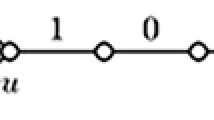Abstract
Given an undirected graph, are there k matchings whose union covers all of its nodes, that is, a matching-k-cover? When \(k=1\), the problem is equivalent to the existence of a perfect matching for which Tutte’s celebrated matching theorem (J. Lon. Math. Soc., 1947) provides a ‘good’ characterization. We prove here, when k is greater than one, a ‘good’ characterization à la Kőnig: for \(k\ge 2\), there exist k matchings covering every node if and only if for every stable set S, we have \(|S|\le k\cdot |N(S)|\). Moreover, somewhat surprisingly, we use only techniques from bipartite matching in the proof, through a simple, polynomial algorithm. A different approach to matching-k-covers has been previously suggested by Wang et al. (Math. Prog., 2014), relying on general matching and using matroid union for matching-matroids, or the Edmonds-Gallai structure theorem. Our approach provides a simpler polynomial algorithm together with an elegant certificate of non-existence when appropriate. Further results, generalizations and interconnections between several problems are then deduced as consequences of the new minimax theorem, with surprisingly simple proofs (again using only the level of difficulty of bipartite matchings). One of the equivalent formulations leads to a solution of weighted minimization for non-negative edge-weights, while the edge-cardinality maximization of matching-2-covers turns out to be already NP-hard. We have arrived at this problem as the line graph special case of a model arising for manufacturing integrated circuits with the technology called ‘Directed Self Assembly’.
Similar content being viewed by others
References
Berge, C., Las Vergnas, M.: On the existence of subgraphs with degree constraints. Indag. Math. 81(1), 165–176 (1978)
Edmonds, J., Johnson, E.L.: Matching: a well-solved class of integer linear programs. In: Guy, H., Sauer, S. (eds.) Combinatorial Structures and their Applications, pp. 89–92 (1970)
Edmonds, J.: Maximum matching and a polyhedron with 0, 1-vertices. J. Res. Natl. Bureau Stand. B 69(125–130), 55–56 (1965)
Fournier, J.C.: Coloration des aretes d’un graphe. Cah. Centre Etudes Rech. Oper. 15, 311–314 (1973)
Gerards, A.: Matching. In: Handbooks of Operations Research and Management Science, Chapter 3, vol. 7, pp. 135–223 (1995)
Holyer, I.: The NP-completeness of edge-coloring. SIAM J. Comput. 10, 718–720 (1981)
Heinrich, K., Hell, P., Kirkpatrick, D.G., Liu, G.: A simple existence criterion for \((g <f)\)-factors. Discrete Math. 85, 313–317 (1990)
Hell, P., Kirkpatrick, D.G.: Packings by cliques and by finite families of graphs. Discrete Math. 49, 45–59 (1984)
Hell, P., Kirkpatrick, D.G.: Packings by complete bipartite graphs. SIAM J. Algebr. Discrete Methods 7, 199–209 (1986)
Hell, P., Kirkpatrick, D.G.: Algorithm for degree constrained graph factors of minimum deficiency. J. Algor. 14, 115–138 (1993)
Kőnig, D.: Graphok és alkalmazásuk a determinánsok és a halmazok elméletére [in Hungarian]. Mat. Term. Ért. 34, 453–465 (1916)
Kőnig, D.: Über Graphen und ihre anwendung auf determinantentheorie und mengenlehre. Math. Ann. 77(4), 453–465 (1916) (English translation by Ágnes Cseh, https://econ.core.hu/file/download/Konig1916.pdf)
Lovász, L., Plummer, M.D.: Matching theory. North-Holland Mathematics Studies. North-Holland, Amsterdam, New York (1986)
Schrijver, A.: Combinatorial Optimization. Springer, Berlin, Heidelberg (2003)
Tutte, W.T.: The factorization of linear graphs. J. Lond. Math. Soc. 22, 107–111 (1947)
Tutte, W.T.: The \(1\)-factors of oriented graphs. Proc. Am. Math. Soc. 4, 922–931 (1953)
Tutte, W.T.: A short proof of the factor theorem for finite graphs. Can. J. Math. 6, 347–352 (1954)
Vizing, V.G.: On an estimate of the chromatic class of a \(p\)-graph, [in Russian]. Diskret. Analiz. 3, 25–30 (1964)
Wang, X., Song, X., Yuan, Y.: On matching cover of graphs. Math. Progr. 147(1), 499–518 (2014)
Wang, X., Song, X., Yuan, Y.: A note on Matching Cover Algorithm. arXiv:1612.00943 (2016)
Acknowledgements
We thank Mentor Graphics for their role beyond the finances of a doctoral work: the problem analyzed here originates from their practical initiatives, related to new technology. Thanks are due to Frédéric Maffray for discovering that matching-k-covers have been studied in [19].
Author information
Authors and Affiliations
Corresponding author
Additional information
Publisher's Note
Springer Nature remains neutral with regard to jurisdictional claims in published maps and institutional affiliations.
Rights and permissions
About this article
Cite this article
Ferhat, D.A., Király, Z., Sebő, A. et al. How many matchings cover the nodes of a graph?. Math. Program. 203, 271–284 (2024). https://doi.org/10.1007/s10107-022-01804-9
Received:
Accepted:
Published:
Issue Date:
DOI: https://doi.org/10.1007/s10107-022-01804-9




